There was a moment in art history (roughly around the mid-seventeenth century) from which artists began, with increasing insistence, to portray themselves in their studio or home. For a long time, the genre of the self-portrait in the studio responded to needs of prestige (the painter wanted to dignify his or her studio) or image-building (since a studio or home tells a lot about the artist). In other eras, the depiction of the home or studio simply became the narrative of one’s everyday life.
Today, during the restrictive measures due to the Covid-19 coronavirus pandemic, all artists were forced, like all of us, to lock themselves in their homes. But how would the great artists of the past have lived if the now beleaguered hashtag #iorestoacasa had been an imperative centuries ago? We took a tour of the homes of fifteen great artists in the history of art to see under what conditions they would have spent their containment measures!
1. Rembrandt van Rijn, The Painter in the Studio.
(c. 1629; oil on panel, 25.1 x 31.9 cm; Boston, Museum of Fine Arts)
We do not know if the studio depicted by Rembrandt (Leiden, 1606 - Amsterdam, 1669) in this painting is actually that of the artist, but given his propensity for self-representation (in fact, Rembrandt left us numerous images of himself), it is highly likely that it is. There is also no certainty about the identification of the painter depicted: for some it may be Rembrandt, for others his great pupil Gerrit Dou. The extreme restraint of this study, bare of anything but the painter’s tools, is striking: evidently the artist did not allow any distractions, or he wanted a clear room to better study the effects of light and shadow. The painting is also surprising in its perspective cut: in order to widen the field, the artist chose to put the easel in the foreground and to place himself at the back of the room, so that the instrument appears gigantic and he much smaller. Perhaps, one could give an allegorical connotation to this element, reading it as a symbolic allusion to the size and toil of the artist’s work.
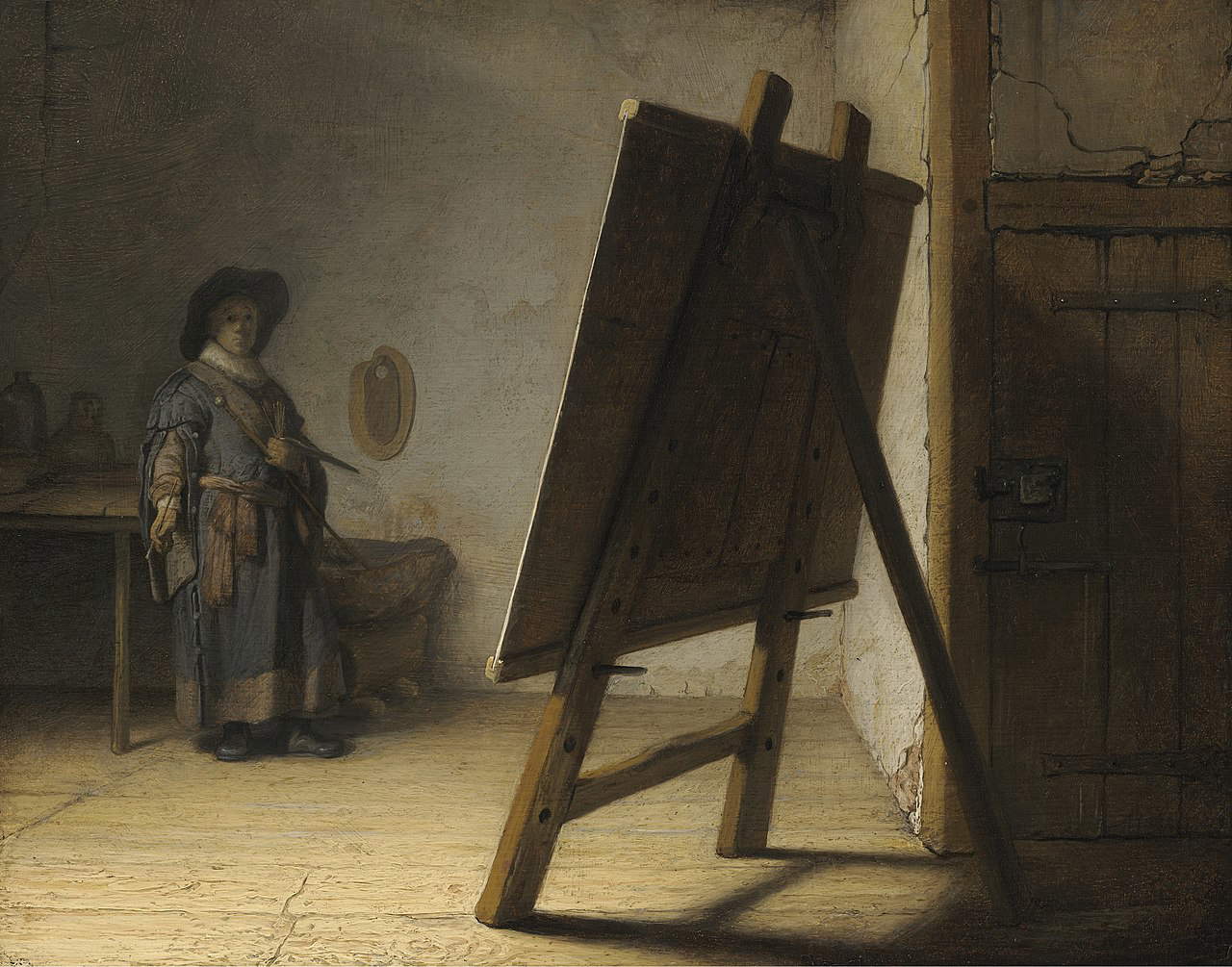 |
| Rembrandt van Rijn, The Painter in the Studio (ca. 1629; oil on panel, 25.1 x 31.9 cm; Boston, Museum of Fine Arts) |
2. Jan Vermeer, Allegory of Painting
(c. 1666; oil on canvas, 120 x 100 cm; Vienna, Kunsthistorisches Museum)
The work is also known as The Atelier because, according to some readings, the protagonist may be Jan Vermeer (Delft, 1632 - 1675) himself as he paints a model inside his studio: an elegant house with a checkerboard interior, fine draperies, velvets, a rich chandelier, and a map hanging on the wall. The map itself is the main clue: it is in fact the map of the so-called Seventeen Provinces (a large state that between 1482 and 1581 the present-day Netherlands, Belgium, Luxembourg, part of northern France and a portion of western Germany), and we know that it was in Vermeer’s house. Reading the painting as an allegory of painting is facilitated by the presence of objects such as the trumpet, a symbol of fame, the book, a symbol of history, and the laurel, an allusion to poetry, all of which have to do with painting. The work is, moreover, one of Vermeer’s major essays of luministic skill.
 |
| Jan Vermeer, Allegory of Painting (c. 1666; oil on canvas, 120 x 100 cm; Vienna, Kunsthistorisches Museum) |
3. Adriaen van Ostade, The Painter’s Studio
(c. 1670-1675; oil on panel, 37 x 36 cm; Amsterdam, Rijksmuseum)
As can be guessed so far, the depiction of the artist’sstudio abounds in seventeenth-century Holland: Dutch painters were in fact particularly inclined to genre scenes, as opposed to their Italian counterparts, and were more inclined than the latter to reflect on the artist’s craft in its everyday life (the Italians, on the other hand, were more interested in the theoretical, philosophical, and allegorical aspects of the profession, which is why paintings with allegories of art and painting as their subject are frequent in seventeenth-century Italy). Adriaen van Ostade (Haarlem, 1610 - 1685), one of the most prolific genre painters of 17th-century Holland, takes these consequences almost to extremes, depicting an artist’s studio (which is almost certainly not his: it is much more likely to be an interior of invention) working in a dilapidated, gloomy building: the conditions in which many artists, far from wealthy (wealthy painters in fact were the very distinct minority), worked at the time. Two pupils also appear in the studio, and a dog sleeps on the floor. All around, in disarray, tools of the trade and objects of everyday studio life tossed here and there.
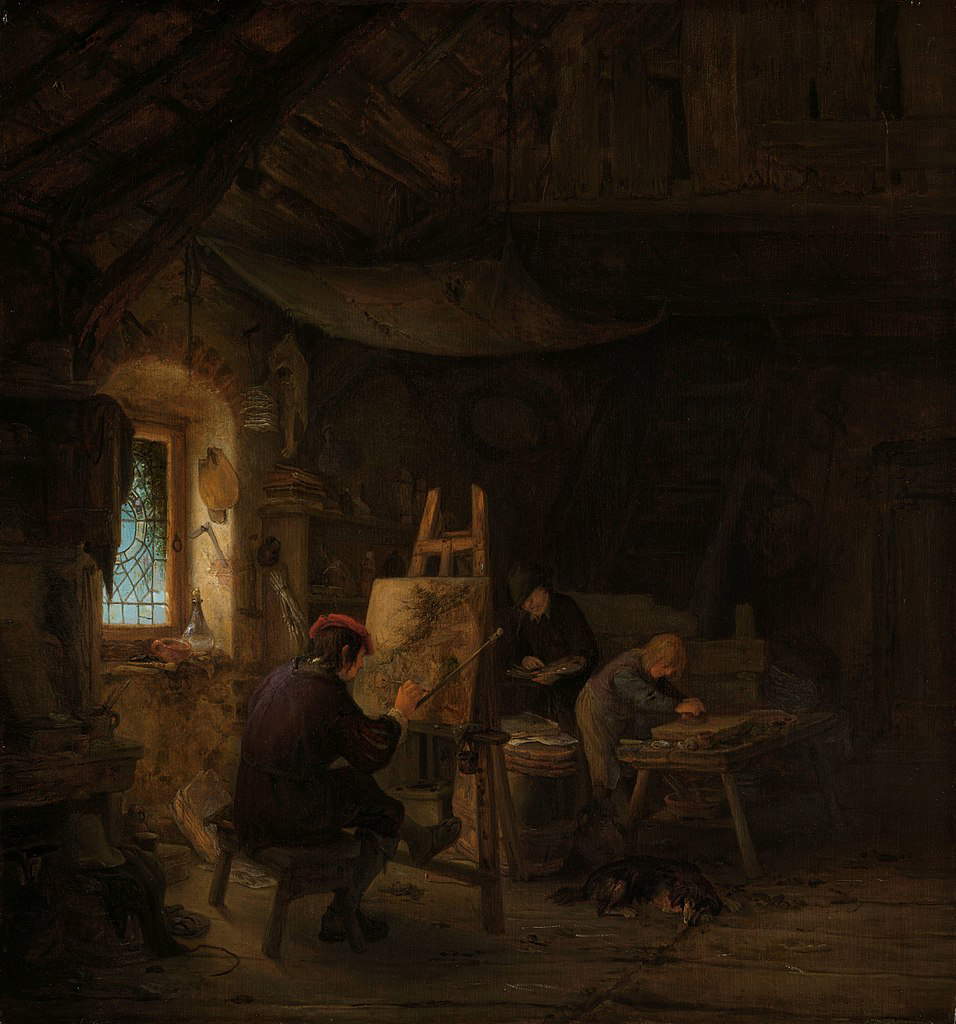 |
| Adriaen van Ostade, The Painter’s Studio (ca. 1670-1675; oil on panel, 37 x 36 cm; Amsterdam, Rijksmuseum) |
4. Pietro Longhi, The Painter’s Studio
(c. 1745; oil on canvas, 44 x 53 cm; Venice, Ca’ Rezzonico, Museo del Settecento Veneziano)
The Venetian painter Pietro Longhi (Pietro Falca; Venice, 1701 - 1785) was the artist who perhaps more than any other was able to capture the society of his city in the eighteenth century, and his painting is thus populated with moments of everyday life in the homes of upper-class Venice, masquerade parties, and days at the circus. Or, as in this case, moments of work in the painter’s studio. The artist is portrayed here with his back turned as he paints a portrait of a lady, accompanied by her husband, who is wearing, in addition to a tricorno (the typical headdress of 18th-century Venice), a bauta, or traditional Venetian mask, momentarily lowered (in ancient Venice, the mask was not only worn at carnival). The artist’s studio is bare, but not missing, leaning against the back wall, is a cello: music, in eighteenth-century Venice, was indeed a vital activity.
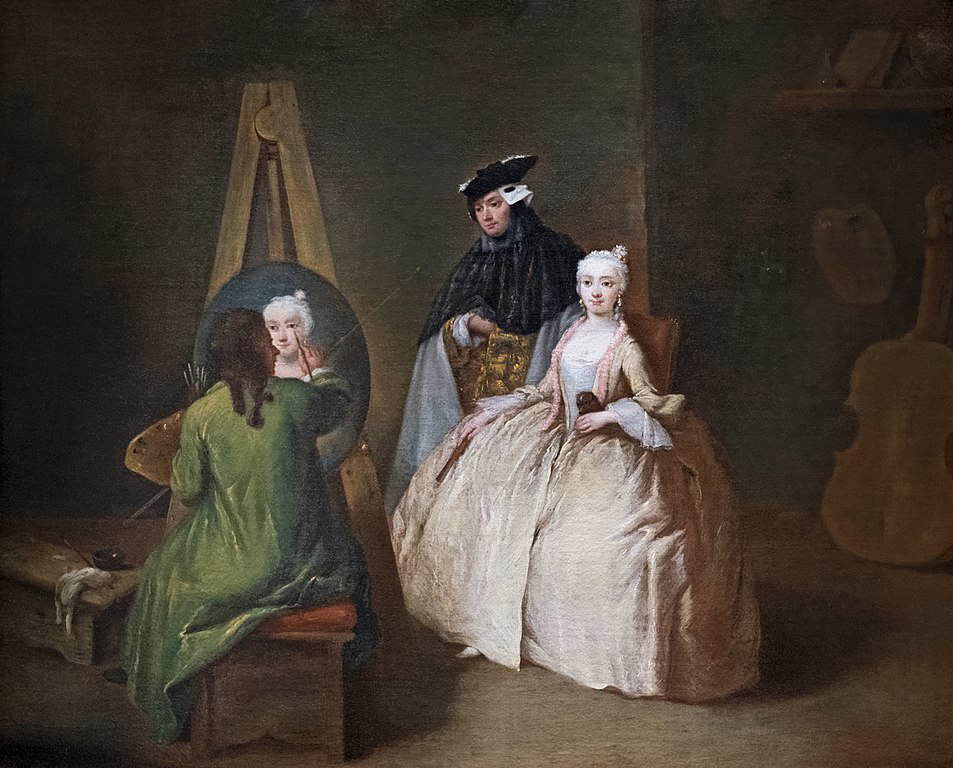 |
| Pietro Longhi, The Painter’s Studio (ca. 1745; oil on canvas, 44 x 53 cm; Venice, Ca’ Rezzonico, Museo del Settecento Veneziano) |
5. Caspar David Friedrich, View from the artist’s studio, left window
(1805-1806; graphite and sepia on paper, 314 x 235 mm; Vienna, Belvedere)
The great Romantic painter Caspar David Friedrich (Greifswald, 1774 - Dresden, 1840) left us some images of his studio, but not only that: he himself was portrayed by his friend Georg Friedrich Kersting inside his room, with a splendid view of the Elbe River, in Dresden. Indeed, a constant in the depictions of Friedrich’s house is the large window open to the landscape: that of the window is a topos dear to Romanticism, since it was the Romantic painters themselves who invented the genre of the “window view.” A sort of middle ground between landscape painting and interior view, or a combination of both: it was the most effective means of representing the dissent of the Romantic soul, uncertain whether to remain anchored to its certainties or to set out to discover the infinite that opens beyond its threshold. It is in this way that we can also read Friedrich’s views, imagining him looking sighingly out the window of his home.
 |
| Caspar David Friedrich, View from the artist’s studio, left window (1805-1806; graphite and sepia on paper, 314 �? 235 mm; Vienna, Belvedere) |
6. Tommaso Minardi, Self-Portrait in the Attic.
(ca. 1813; oil on canvas, 37 �? 33 cm; Florence, Uffizi Gallery)
Although Tommaso Minardi (Faenza, 1787 - Rome, 1871) is perhaps not one of the most famous artists in the history of Italian art (although he is one of the most relevant of the first half of the 19th century: he was also a signatory of the Manifesto of Purism), his very famous Self-Portrait is one of the most famous images of the Italian 19th century, since it is one of the first paintings of its kind and responds to the desire of the artists of the time to offer a certain type of image to an ever wider public: the artist thus becomes, in this case, a kind of ante litteram bohemian living in a cramped world of clutter, study, books, and long, solitary reflections (we sense this from the skull-posted on the bedside table). We may not have to imagine it as a realistic study (who knows if Minardi really had all those skulls in the house), but it is certainly an image not far from the truth.
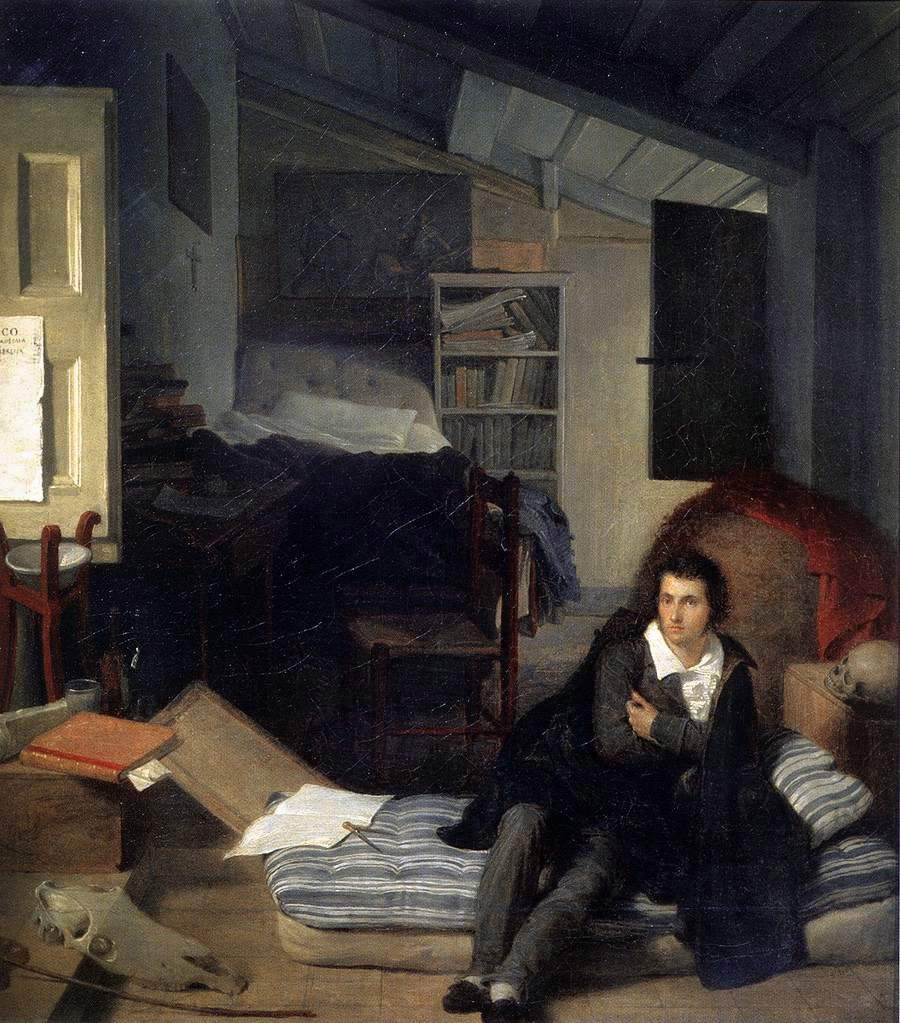 |
| Tommaso Minardi, Self-Portrait in the Attic (ca. 1813; oil on canvas, 37 x 33 cm; Florence, Uffizi Gallery) |
7. Leon Cogniet, The artist in his studio at the Villa Medici in Rome
(1817; oil on canvas, 44.5 x 37 cm; Cleveland, Cleveland Art Museum)
A very young Léon Cogniet (Paris, 1794 - 1880), a painter trained in the mould of Neoclassicism but soon the author of a decidedly Romantic turn (already evident in this painting), won the Prix de Rome in 1817, which guaranteed him a five-year study period in Rome, at the Villa Medici (which, moreover, is still home to the Academy of France). His room has a window open to the Roman landscape, and this is very telling because, in Italy, Cogniet was struck by landscapes and ruins. “What struck me most of all,” he wrote in one of his letters shortly after arriving in Rome, “was the beauty of nature, but not only that of the place where I live: all the nature I have crossed from the French border onward.” And as is the cliché of the Romantic artist, books, clutter, disparate objects abound in Cogniet’s room as well: a guitar, writing papers, small squares, a chest with cloths thrown about in bulk, even a shield with two swords. The artist, however, is leaning against his very tall bed.
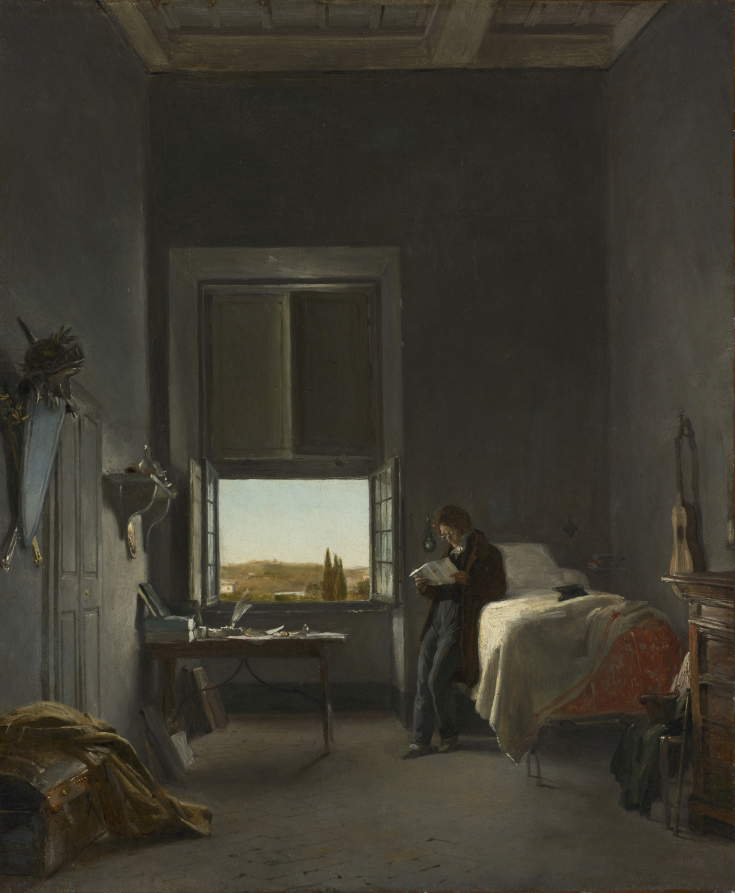 |
| Tommaso Minardi, Self-Portrait in the Attic (ca. 1813; oil on canvas, 37 x 33 cm; Florence, Uffizi Gallery) |
8. Frédéric Bazille and �?douard Manet, The Atelier of Bazille
(1870; oil on canvas, 98 x 128.5 cm; Paris, Musée d’Orsay)
Frédéric Bazille (Montpellier, 1841 - Beaune-la-Rolande, 1870), a very promising artist, among the first Impressionists (he would have become one of the greatest, had he not died at only twenty-nine during the Franco-Prussian War: he had enlisted as a volunteer), paints here the Parisian studio he shared with Renoir during the last two years of his life. The painter is depicted in the center, holding a palette; he is the tallest of the figures. We know that it was �?douard Manet who painted the figure of Bazille, who is instead the character with the hat next to Bazille. In this two-story workshop-atelier we find everything that meant art to Bazille: something all-encompassing and all-consuming, something that went beyond the Academy (indeed, on the walls hang paintings of his friends rejected by the official Salons) and was necessarily shared.
| <img src=’https://cdn.finestresullarte.info/rivista/immagini/2020/1277/frederic-bazille-atelier.jpg ’ alt=“Frédéric Bazille and <a href=”https://www.finestresullarte.info/arte-base/edouard-manet-tra-realismo-e-impressionismo-vita-stile-opere“>�?douard Manet</a>, Bazille’s Atelier (1870; oil on canvas, 98 x 128.5 cm; Paris, Musée d’Orsay) ” title=“Frédéric Bazille and �?douard Manet, Bazille’s Atelier (1870; oil on canvas, 98 x 128.5 cm; Paris, Musée d’Orsay) ” /> |
| Frédéric Bazille and �?douard Manet, Bazille’s Atelier (1870; oil on canvas, 98 x 128.5 cm; Paris, Musée d’Orsay) |
9. Vincent van Gogh, Vincent’s Room at Arles
(1888; oil on canvas, 72 x 90 cm; Amsterdam, Van Gogh Museum)
It is perhaps the most famous “artist’s house” in the history of art: the famous room of Vincent van Gogh (Zundert, 1853 - Auvers-sur-Oise, 1890) in his home in Arles, Provence, where the artist had moved in 1888 in search of the wonderful southern light. The painting is known in three versions (one preserved at the Van Gogh Museum in Amsterdam, another at the Art Institute of Chicago, and one at the Musée d’Orsay in Paris: the one in the Dutch capital, however, is the only one painted in Arles; the other two date from 1889 and were executed in Saint-Rémy) and is particularly beloved because it depicts the artist’s quiet daily life at the time: the interior of the so-called “yellow house” is particularly bare, we see nothing but a coat rack, a small table, a couple of chairs, a dirty mirror, a towel hanging directly on the wall, and a few paintings gracing the room. Psychological interpretations have also been given of this painting (also reproduced by van Gogh in a couple of letters), without ever arriving at a certain reading: for van Gogh it was “a kind of revenge for the forced rest to which I was obliged” (the artist was in fact ill when he painted the work and could not leave the house). The color, then, by his own admission was supposed to “suggest rest or sleep.” In these words might be concealed the key to better understanding this very famous painting.
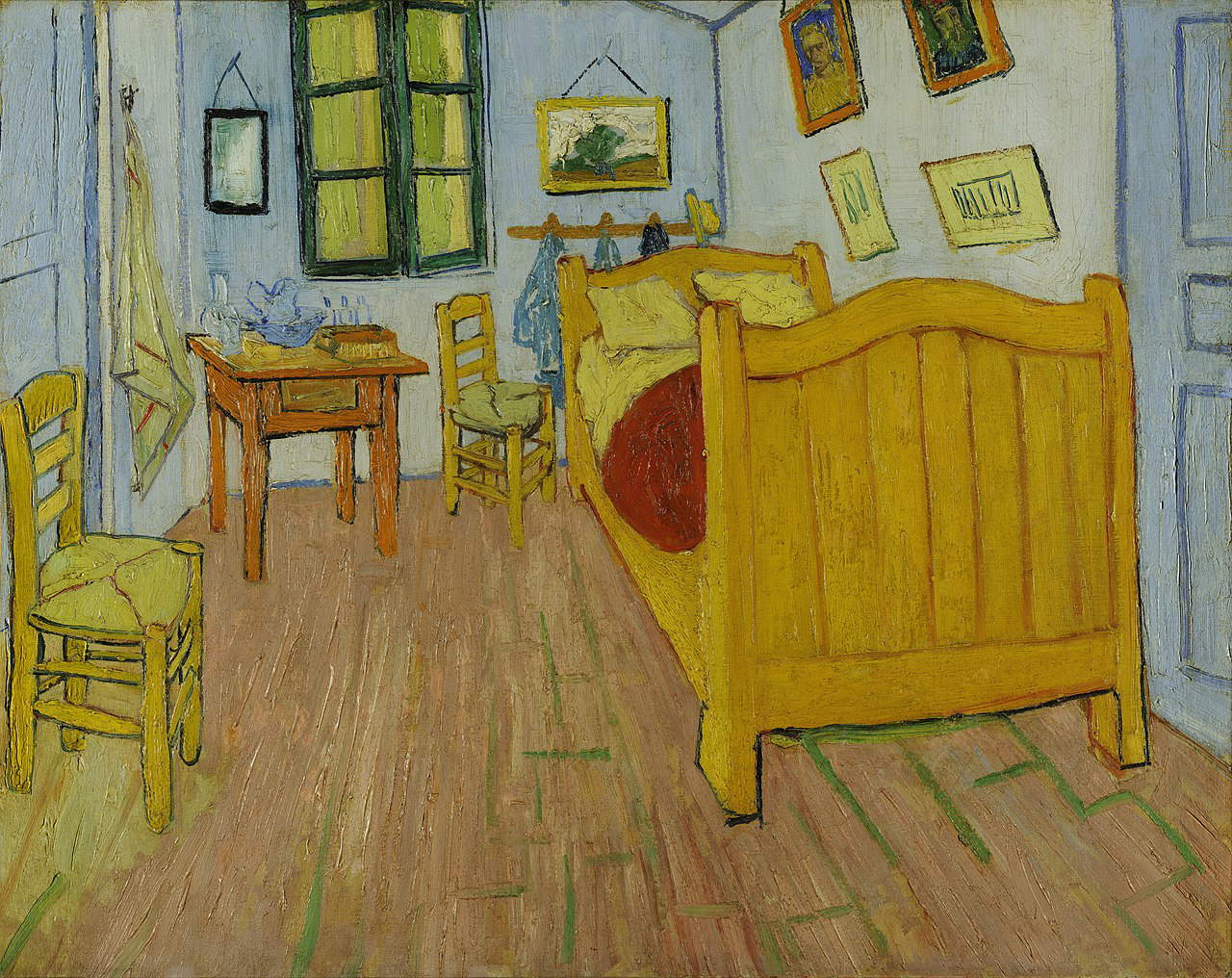 |
| Vincent van Gogh, Vincent’s Room at Arles (1888; oil on canvas, 72 x 90 cm; Amsterdam, Van Gogh Museum) |
10. Joaquín Sorolla, The Painter’s Studio.
(1888; oil on canvas, 50 x 76 cm; Madrid, Museo Sorolla)
A very young Joaquín Sorolla (Valencia, 1863 - Cercedilla, 1923), just 25 years old, shows us here his youthful studio, all cluttered and cluttered: we are drawn to the model, a naked little boy lying on top of a couch, the dog sleeping on the floor, as well as the many paintings thrown haphazardly in all corners. The selection of works gives us clues to Sorolla’s tastes at the time: there are reproductions of Velázquez’s portrait of Pope Innocent X and a Greek bas-relief by Phidias.
 |
| Joaquín Sorolla, The Painter’s Studio (1888; oil on canvas, 50 x 76 cm; Madrid, Museo Sorolla) |
11. Claude Monet, The Artist’s Garden at Giverny
(1900; oil on canvas; 81.6 x 92.6 cm; Paris, Musée d’Orsay)
Although the beginnings of his career were not easy for Claude Monet (Paris, 1840 - Giverny, 1926), the father ofImpressionists-who-were-principal-artists-impressionism">impressionism, soon success came his way and with the proceeds of his painting activity he was able to buy a house in Giverny, Normandy, equipped with a large garden where he could devote himself to his great passion: that of gardening, precisely. The celebrated water lilies that abound in his later production are precisely those he had planted in a tank he had specially installed in the garden. And parallel to the water lily paintings, views of his garden abound in the last phase of Monet’s activity: such as this one, colorful enough to render the impression of a walk among the many flowers with which the painter loved to surround himself.
 |
| Claude Monet, The Artist’s Garden at Giverny (1900; oil on canvas; 81.6 x 92.6 cm; Paris, Musée d’Orsay) |
12. André Derain, Self-Portrait in the Studio.
(c. 1903; oil on canvas; 42.2 x 34.6 cm; Canberra, National Gallery of Australia)
A youthful work executed at the age of twenty-three, this Self-Portrait in the Studio by André Derain (Yvelines, 1880 - Garches, 1954) is a painting that predates the artist’s fause fauve, but the direction of his art is now clear, with painting already directed toward the art of Matisse. The artist painted it looking at himself in a mirror, in a rapid manner, with a palette that alternates very vivid and light parts with darker areas (the artist himself paints himself against the light). Derain and Matisse were already acquainted at the time, although it is difficult to say whether this painting was executed on the back of Matisse’s achievements. The studio is particularly bare, and we see nothing but a window and a cabinet with some tools of the trade.
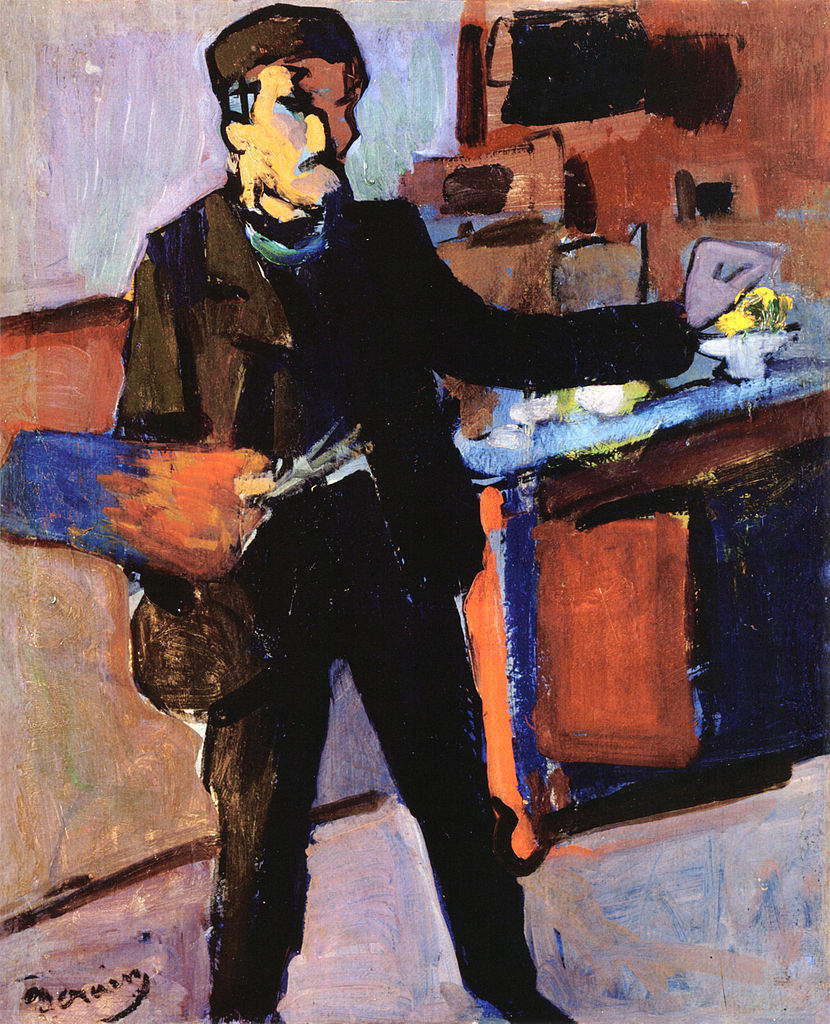 |
| André Derain, Self-Portrait in the Studio (c. 1903; oil on canvas; 42.2 x 34.6 cm; Canberra, National Gallery of Australia) |
13. Umberto Boccioni, Self-Portrait
(1908; oil on canvas; 70 x 100 cm; Milan, Pinacoteca di Brera)
This Self-Portrait is one of the most famous paintings by Umberto Boccioni (Reggio Calabria, 1882 - Verona, 1916): the artist depicts himself, in the middle of winter, on the balcony of his apartment in Milan, in a newly constructed building (we see in the background the construction sites of the growing city) in the suburbs, on Via Castel Morrone. Here, Boccioni has not yet switched to Futurist poetics, although we can glimpse it in nuce in the lashing brushstrokes of the coat: the artist is still close to pointillism. The work had not fully satisfied the artist, who in a note dated May 13, 1908, thus wrote: “Since the first of the month I have been in mamma’s house, away from thatantipathic mistress, and I am quite well. In that house I finished theutoritratto which leaves me completely indifferent.”
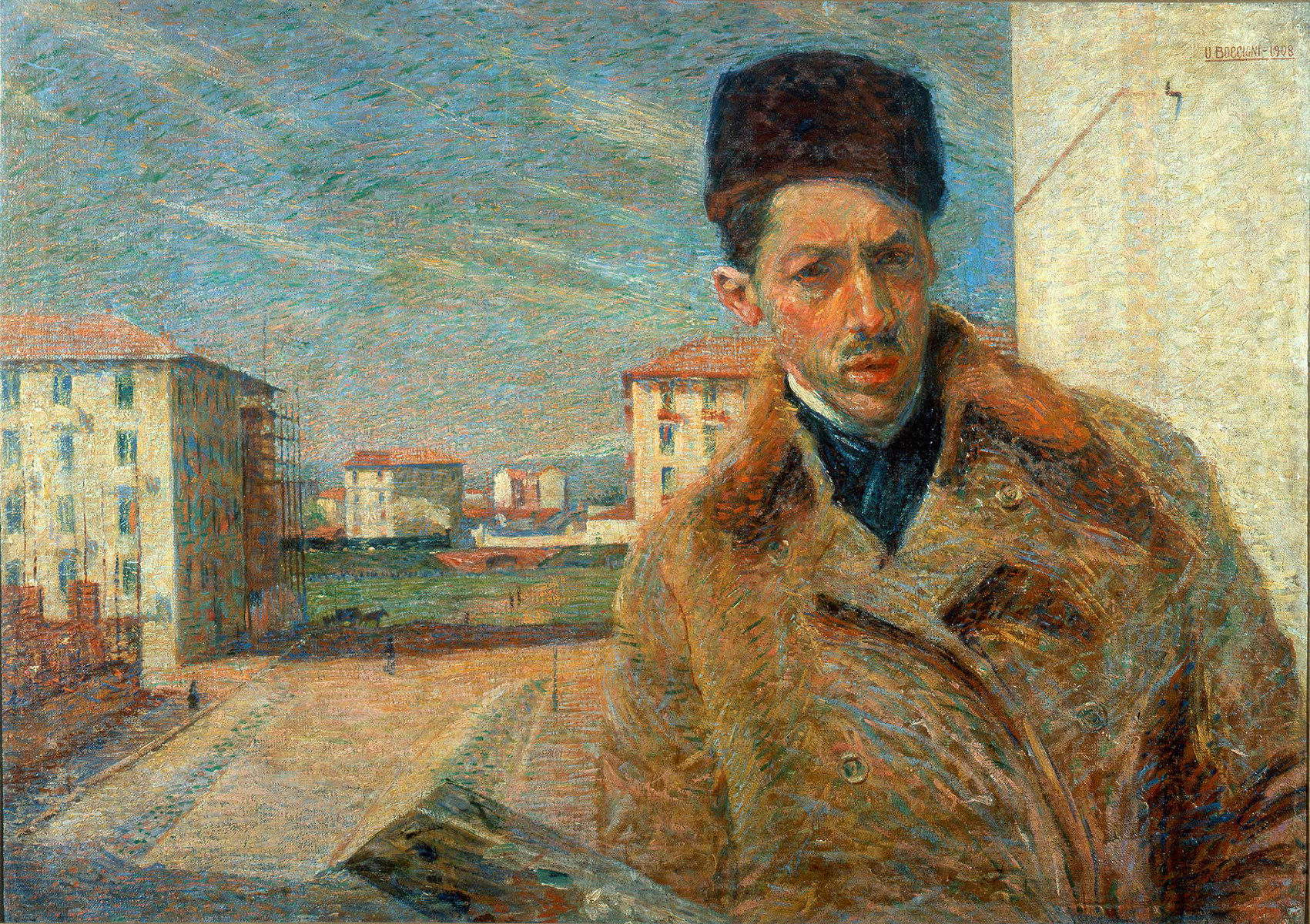 |
| Umberto Boccioni, Self-Portrait (1908; oil on canvas, 70 x 100 cm; Milan, Pinacoteca di Brera) |
14. William Ratcliffe, The Artist’s Room at Letchworth
(c. 1932; oil on paper, 457 x 552 mm; London, Tate Gallery)
Among the major British artists of the early twentieth century, William Ratcliffe (Clenchwarton, 1870 - Hampstead, 1955) painted around 1932 this interior of the house of his friend Stanley Parker, where he stayed for some time. The work gives us a way into a middle-class home in England at the time: the dwelling was located in Letchworth, uan town founded in 1903 in the form of a garden city. The amenity of the dwelling is also suggested by the colorful interiors.
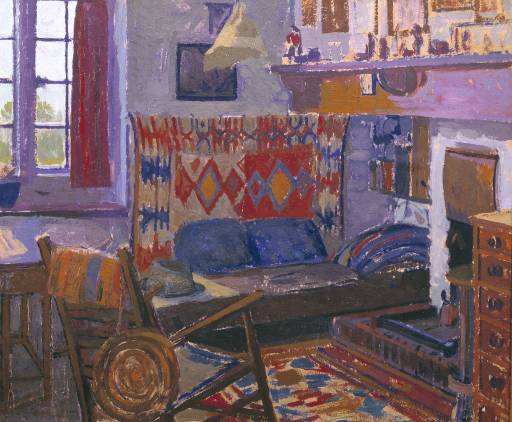 |
| William Ratcliffe, The Artist’s Room at Letchworth (c. 1932; oil on paper, 457 x 552 mm; London, Tate Gallery) |
15. Giorgio De Chirico, Self-Portrait in the Studio.
(1934; oil on canvas; Rome, Galleria Nazionale d’Arte Moderna e Contemporanea)
Giorgio De Chirico’s (Volos, 1888 - Rome, 1978) passion for the antique is evident in this Self-Portrait in the Studio from the bust that the painter depicts resting on the ground near his easel. It is an almost solemn painting, with the self-assured artist posing as he turns his gaze to the viewer, in a bare but orderly interior, as he has just begun to trace the outlines of the figure on the canvas. De Chirico’s self-portraits are numerous: a way of asserting his own image.
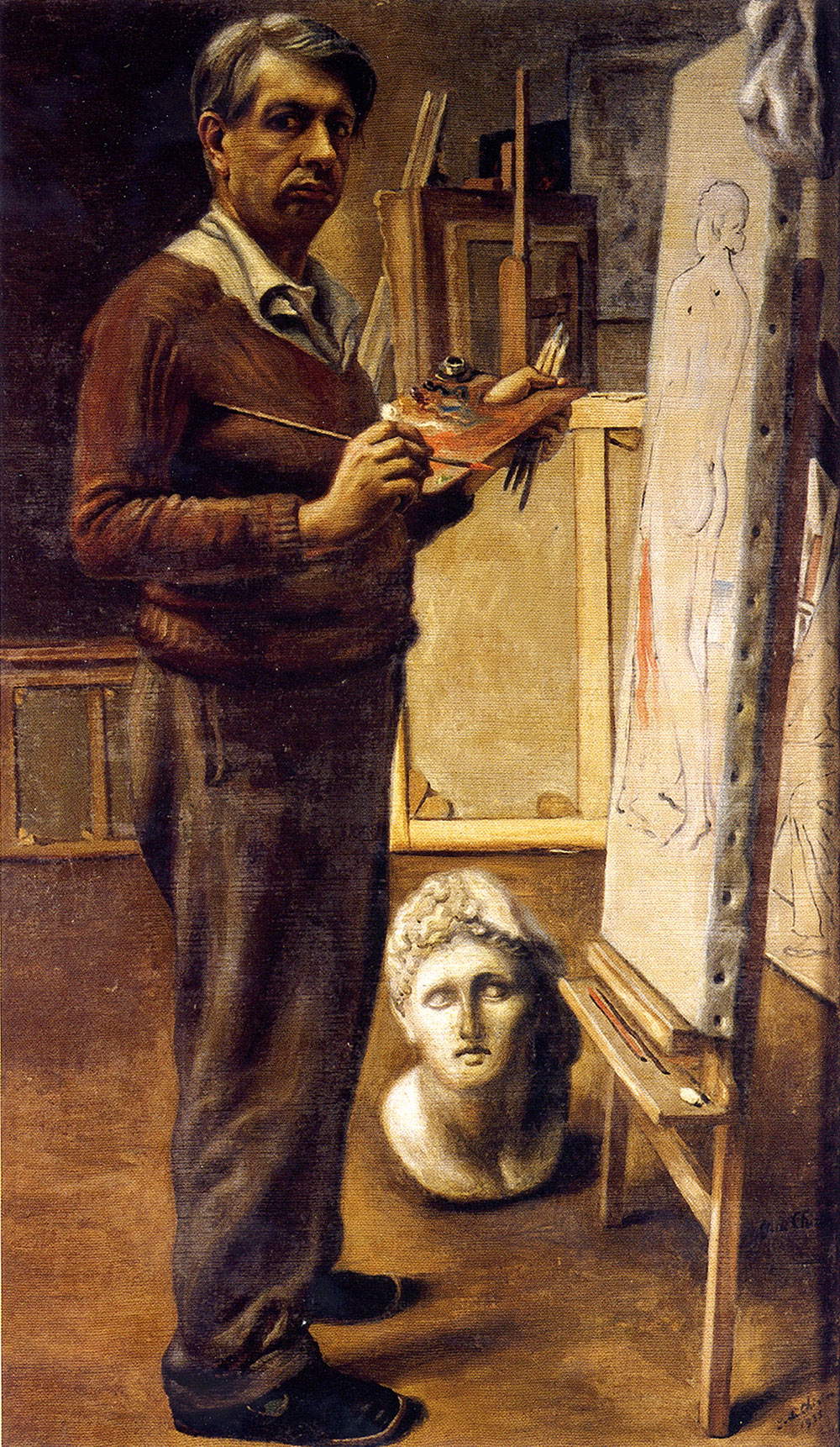 |
| Giorgio De Chirico, Self-Portrait in the Studio (1934; oil on canvas; Rome, Galleria Nazionale d’Arte Moderna e Contemporanea) |
Warning: the translation into English of the original Italian article was created using automatic tools. We undertake to review all articles, but we do not guarantee the total absence of inaccuracies in the translation due to the program. You can find the original by clicking on the ITA button. If you find any mistake,please contact us.